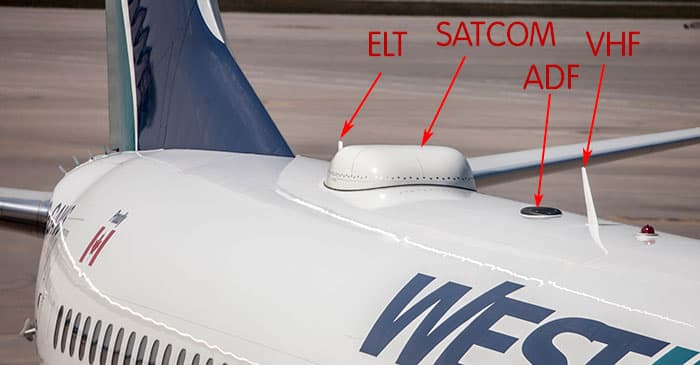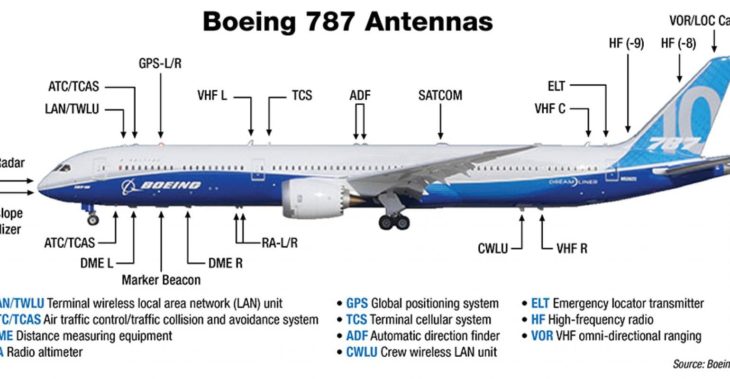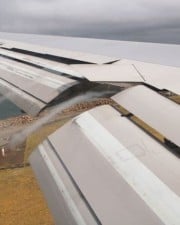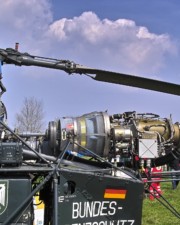If you’re an airplane buff, chances are good that you’ve wondered what all of their antennas were for at some point. How do the pilots communicate with people on the ground? Where does airplane WiFi come from? Which antennas do they use for what? Some of these questions have some interesting answers, but none of them are complicated or difficult to understand.
Table of Contents
Antenna Shapes and Sizes

On any airplane, often on its belly, you’ll find dozens of antennas that are each used for a different purpose. Called aerials by a lot of pilots who have been in the business for a while, these antennas are there mostly to help the pilots communicate with other people, and most of them look like lightning rods or other interesting protrusions.
Aircraft antennas can have many different shapes and sizes, which are largely determined by the manufacturer itself. Antennas, however, are formed more for their function than anything else, and their shape and placement are usually determined by their directional qualities and the frequencies they use to operate. Essentially, these antennas need to be certain shapes and placed in certain spots to operate correctly.

Aircraft Antenna Types
If you’re curious about the major types of antennas used by airplanes, read on.
1. Communications Antennas

When most laypeople think of aircraft antennas, they assume they are there for effective communication, which is correct. Com antennas are usually mounted on either the top or bottom of the aircraft, and their only concern is being affected by the shadowing of the fuselage. Each com transmitter has its own antenna, and the antenna are strategically placed mainly because their range and coverage can be negatively affected if positioned incorrectly.
The way they work is fairly simple, and their placement is crucial to them being efficient in their purpose. For example, the radio feeding the top antenna usually works best for communicating while the plane is still on the ground, while the one feeding the antenna on the bottom of the plane will usually work best when the plane is in the air. It isn’t difficult to figure out why.
2. GPS Antennas

Transmitting less than five watts of power, GPS antennas result in signals that are usually very weak. Because of this, most GPS antennas consist of built-in amplifiers that are designed to boost the signal for the receiver. In addition, the GPS frequency is very high, usually in the gigahertz band, which requires that the GPS antenna to be attached to the very top portion of the fuselage.
Communications antennas can cause interference with GPS antennas, which means that the two antennas should be placed as far away from each other as possible. Suction cup antennas are often used with hand-held GPSs, but they can spell disaster when placed in certain areas, such as in the windows. This is but one of the reasons why IFR certification with hand-held GPSs is likely not going to happen anytime soon.
3. Loran Antennas
Long-range navigation, or Loran antennas, look a lot like communications antennas until you look on the inside. Loran antennas usually contain either an amplifier built into their base so that the signal is better or a smaller amplifier located just under the skin. They are meant to be placed either on the top or bottom of the plane, but you must configure the receiver to fit the exact antenna position for them to work properly.
Loran systems are very prone to P-static, which results from electrical charge buildup should the plane fly through heavy dust or rain. However, if you bond the airframe structures and antennas properly, this often prevents that from happening. Static buildup is also caused when the vinyl stickers found on the vertical fin decide to attract static buildup and other types of interference.

4. Loop Antennas
Aircraft antennas also include loop antennas, which are shaped like – you guessed it – loops. They are also called directional antennas because they can actually determine which direction a signal is coming from. They consist of two or three separate coils that make them look like a flattened bagel, and each signal is received between the coils at various strengths.
Loop antennas are usually short and wide, hence their bagel-like shape, and they can be found on either the top or bottom of the aircraft, although they are usually on the bottom. These are the types of antennas that lightning detection systems usually use. They tend to hold oil and water and, therefore, a good seal job is always recommended to prevent water buildup and to make the antennas last longer.
5. Marker Beacon Antennas
Marker beacon antennas have to be on the bottom of the aircraft because to receive any signal, the antennas have to be almost directly over the transmitting ground station. There are many different types of marker beacon antennas, with the most common ones resembling little canoes that are roughly 10 inches long. They are both simple and reliable.
Cessna has used modified versions of the marker beacon antenna with great success. These include flush antennas located under the empennage that look like flat plates, and antennas that have thick wires that protrude straight down from the empennage and then turn towards the tail of the plane. Both of these types of marker beacon antennas have proven to be very successful.
6. Nav Antennas
Almost always found on the vertical tail, nav antennas come in three main types. The cat whisker has several rods jutting out from each side of the stabilizer at 45-degree angles. It is a good antenna to have when you’re flying low because it cannot receive signals from the side. A second type, the dual blade, has antennas on either side of the tail.
A third type of nav antenna, the towel bar, is a balanced loop antenna that can easily receive signals from all directions. Towel bar antennas are found on both sides of the tail of the airplane and are often required for area navigation (RNAV) systems.

7. Radio Altimeters
These antennas, which look like six-inch-square plates, are placed on the bottom of the aircraft. They are usually either a single- or dual-antenna system, and the radar signal is transmitted straight down and literally bounces off of the ground. Radio altimeters include high frequencies and, therefore, require a secure electrical bond with the skin of the airplane.
You can determine the distance above the ground by measuring the time between the transmission of the signal and when the signal is received. Again, the secure bond of the antenna is a must; otherwise, the system talks to itself and causes false readings.
8. UHF Antennas
Utilized mostly for distance-measuring equipment (DME) and transponders, UHF aircraft antennas are only around four inches long and are always found on the bottom of the aircraft. They can be used for both DMEs and transponders, and their two main types are blade and spike antennas. Spike antennas should only be used for transponders, while blade antennas work best with DMEs.
When the landing gear of an airplane is down, it can shadow UHF antennas because of their small size, and spike antennas are even prone to trouble due to things like errant scrub brushes. Biannual transponder checks are also highly recommended, in part because blade antennas can have oil and water buildup and, therefore, may distort the transmitted signal.
Related Posts












